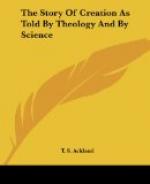[Footnote: Bode’s “Law of Planetary Distances,” What holds good as far as Uranus, breaks down in the case of Neptune. Both Leverrier and Adams were to some extent misled by this law. The new planet should according to their calculations, based on this law, have been of greater magnitude and at a greater distance than Neptune.
The polar axis of Uranus, instead of being nearly perpendicular to the ecliptic, as in the case of all the other planets (except Venus), is nearly coincident with it. Venus occupies an intermediate position, the inclination of its equator to its orbit being 49 degrees 58’.]
There is also strong reason for believing that the sun is still a nebulous star, that the whole of the original nebula is not yet gathered up in the vast globe which at ordinary times is all that we can see. This aspect of the case, however, will come more fully under our notice when we come to the work of the fourth day. The figure of the earth, which is that naturally assumed by a plastic mass revolving about its axis, and the traces which it retains of a former state of intense heat, are both in accordance with this theory.
When these facts are duly weighed, there seems to be a reasonable probability that this process is the one which was actually employed in the formation of the solar system. The remarkable manner in which the theory adapts itself to the Mosaic account, and the fact that that account records special interferences of the Creator exactly at the points where the theory shows that such interferences would be necessary, give rise to a very strong presumption in its favour. We have in it also a clear illustration of the combination of general laws of nature with special interferences of Creative Power—the law of gravitation was called into action, and the work would proceed steadily under that law for a considerable period, till matters were ripe for a farther stage in the progress, and then the special interference would take place, in this instance the imparting the motion of rotation, and the work would again proceed under the natural law. All this while, however, the work would be one, and performed by one power, the only difference being in the direct or indirect action of that power.
The only point an reference to the first day which remains to be inquired into is the extent to which the work had proceeded at its close. As the commencement of the second day’s work implies that at that time the earth had an independent existence, we may conclude that the first day’s work comprehended the casting off of the several successive rings, and the condensation of those rings, or some of them, into the corresponding planets and satellites. These would probably still retain their intense heat, in virtue of which they would be luminous.




